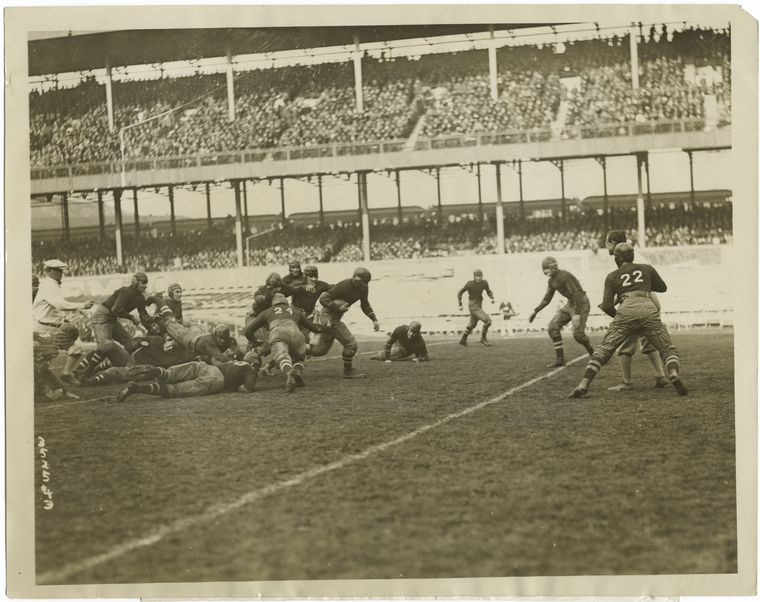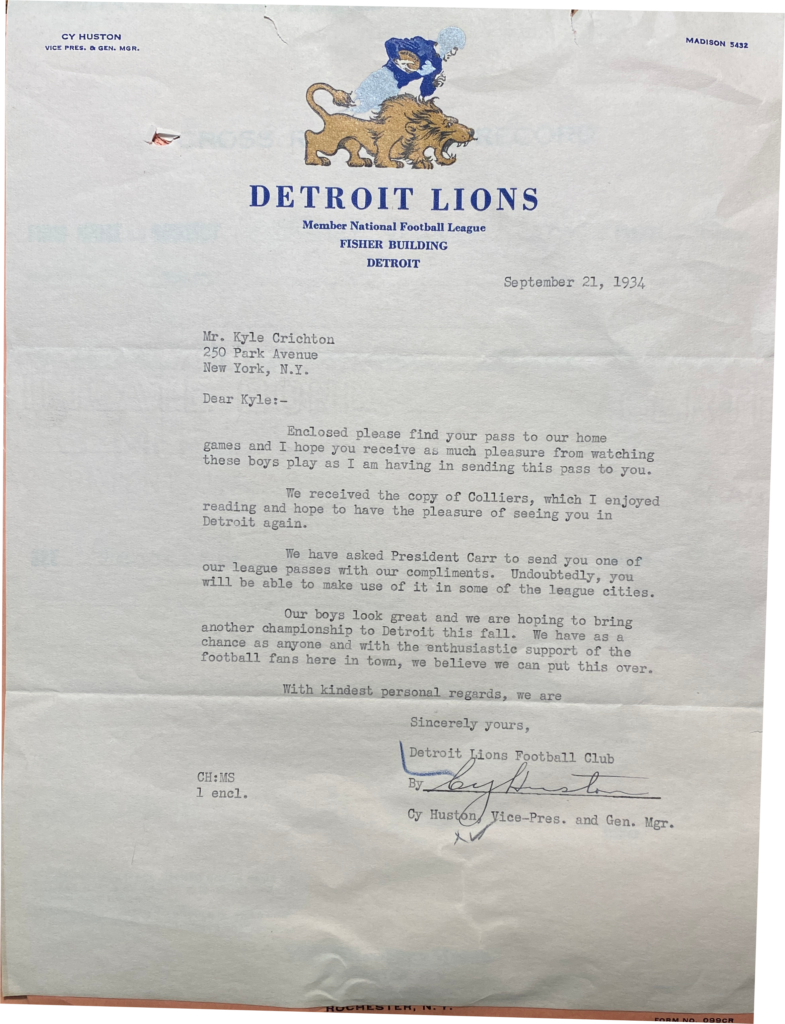Growing up in 1980s upstate New York in a family of Patriots fans, I chose the Detroit Lions as my team because their uniforms were awesome, they played on Thanksgiving, and Barry Sanders.
Unhappily, the four championships the Lions have won – 1935, 1952, 1953, 1957 – were all before the Super Bowl was begun in 1966, so the team has never won or even played in the Super Bowl.
Recently, at the New York Public Library, looking for obscure literary needles in huge periodical haystacks – their immense Crowell-Collier collection, innumerable boxes stacked with rejection letters and internal reference docs and cc’s – I came across this letter from Lions Vice-President and General-Manager Cy Huston, to writer Kyle Crichton, featuring the brilliant early Lions logo.
Crichton was a staff writer at Collier’s for fifteen years and author of many books, including biographies about the Marx Brothers, and Wild West gunslinger Elfego Baca; and novels including The Proud People. He also edited a book about the New York Giants by actress Laraine Day (in many films including Hitchcock’s Foreign Correspondent) among many other projects.
This letter from September, 1934 was written by Cy Huston, just after the team had been purchased for $15,000 by George A. Richards, owner of Detroit radio station WJR. Richards was a devoted supporter and promoter of infamous anti-Semite fascist Father Charles Coughlin.
The team was moved from Portsmouth, Ohio – the Portsmouth Spartans – to Detroit and renamed the Lions in cameraderie with the city’s baseball Tigers.
It is not clear what, if any, Collier’s piece Huston is referencing that he “enjoyed reading” – but the forthcoming December 1, 1934 issue of Collier’s featured Crichton’s article about the Lions, “For Love and Money,” which includes a description of a professional football team’s travel schedule at the time:
“On one tour they left Portsmouth on Friday morning, reached New York Saturday night and beat the Giants Sunday afternoon. They left New York Monday morning and reached St. Louis at six o’clock Wednesday night and played the Gunnars at eight o’clock and beat them. Then they left on Thursday morning for Chicago, where they beat the Bears on Sunday.”
And for New Yorkers, Crichton’s article includes the fact that the Columbia University Lions football team produced the great Cliff Montgomery, who “the whole league is watching” as “the star of the Rose Bowl, who is now with [the] Brooklyn [Dodgers].” (A few years later writer Jack Kerouac would become the most famous Columbia football player not famous for football when he played on scholarship in 1940, breaking his leg in his 2nd game, before making money writing papers for fellow students.)
Crichton’s article reveals that, at the time, the NFL was often considered inferior to college football teams. So eager was the NFL to prove itself, that the article insists: “a Potsy Clark [coach of Detroit] team … is better trained and coached than any college team could possibly be. Tim Mara, owner of the New York Giants, has a standing bet of $10,000 that in a game against the best college team available any of the first five teams in the pro league will make more touchdowns than the college team will first downs.”
Tim Mara, a poor Irish kid from New York City’s Lower East Side, was a legendary bookie and an integral part of what became the NFL, who was responsible for Detroit losing their professional team in 1928 when he purchased the Detroit Wolverines to pilfer their best players (like Benny Friedman) for the Giants, and shut down the Wolverines who played no more. Detroit had its revenge in 1935 when the Lions defeated the Giants in the NFL Champioinship, 26 to 7.

from the New York Public Library

from the New York Public Library


![newspaper article Detroit Free Press, Wednesday, April 11, 1934 'Sure We'll Have a Winner,' Say Officials of Detroit's Pro Grid Team. [picture of 4 white men, captioned with their names: M. J. Caplan, Cy Huston, J. F. Carr, H. N. Snyder] "Grid Franchise Awarded to Detroit's New Pro Team. President of National League Declares City Will Have Contending Club. By Tod Rockwell."](https://www.handoutzine.com/wp-content/uploads/2024/01/Detroit_Free_Press_Wed__Apr_11__1934_2-937x1024.png)

